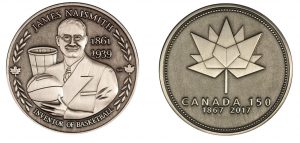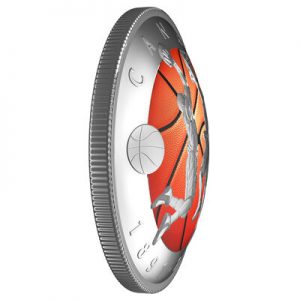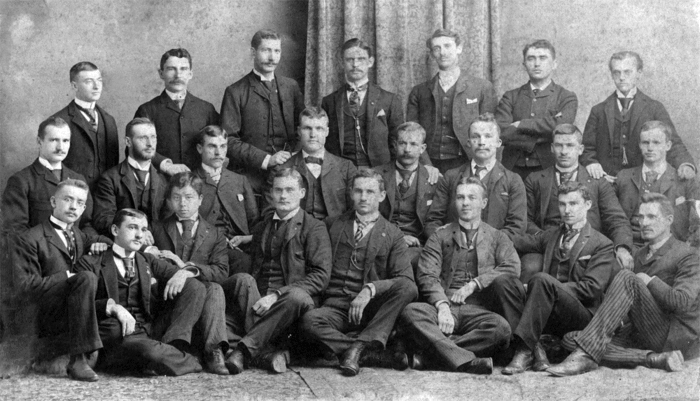On today’s date in 1891, James Naismith, a 30-year-old YMCA trainer from Almonte, Ont., invented the game of basketball.
Working as a physical-education teacher at a school in Springfield, Mass., Naismith was asked to develop an indoor game with minimal physical contact to keep a group of incorrigible students busy during the harsh winter months between football and baseball seasons.
Inspired by a childhood game called “duck on a rock,” he developed the following 13 rules:
- The ball may be thrown in any direction with one or both hands.
- The ball may be batted in any direction with one or both hands, but never with the fist.
- A player cannot run with the ball. The player must throw it from the spot on which he catches it, allowance to be made for a man running at good speed.
- The ball must be held by the hands. The arms or body must not be used for holding it.
- No shouldering, holding, pushing, striking or tripping in any way of an opponent. The first infringement of this rule by any person shall count as a foul; the second shall disqualify him until the next goal is made or, if there was evident intent to injure the person, for the whole of the game. No substitution shall be allowed.
- A foul is striking at the ball with the fist, violations of Rules three and four and such as described in Rule five.
- If either side makes three consecutive fouls it shall count as a goal for the opponent.
- A goal shall be made when the ball is thrown or batted from the grounds into the basket and stays there, providing those defending the goal do not touch or disturb the goal. If the ball rests on the edges, and the opponent moves the basket, it shall count as a goal.
- When the ball goes out of bounds, it shall be thrown into the field and played by the first person touching it. In case of dispute the umpire shall throw it straight into the field. The thrower-in is allowed five seconds. If he holds it longer, it shall go to the opponent. If any side persists in delaying the game, the umpire shall call a foul on them.
- The umpire shall be the judge of the men and shall note the fouls and notify the referee when three consecutive fouls have been made. He shall have power to disqualify men according to Rule five.
- The referee shall be judge of the ball and shall decide when the ball is in play, in bounds, to which side it belongs, and shall keep the time. He shall decide when a goal has been made and keep account of the goals, with any other duties that are usually performed by a referee.
- The time shall be two fifteen-minute halves, with five minutes rest between.
- The side making the most goals in that time is declared the winner.
Naismith called it “boxball” and asked a janitor to nail two peach baskets at opposite ends of the gymnasium, and his class was split into teams of nine players.
On Dec. 21, 1891, the first game of basketball was played at the YMCA International Training School. Initially, soccer balls were used to throw into the baskets, whose bottoms were later cut out, and dribbling was prohibited (only passing the ball could move it up the court).
Naismith eventually published the rules of basketball on Jan. 15, 1892.
BASKETBALL COINS, MEDALLIONS
In 1999, the Royal Canadian Mint issued a silver 50-cent coin commemorating the invention of basketball.
It was one of the 12 coins issued as part of the “Canadian Sports Firsts” series between 1998 and 2000.

A medallion celebrating the 125th anniversary of basketball’s invention was struck by Alliance Coin & Banknote in 2018.
In 2011, a limited-edition $4 trade token marking the 150th anniversary of Naismith’s birth was designed and minted by Alliance Coin & Banknote in Almonte, Ont. Measuring 31.75 millimetres in diameter, the coin was struck from brass and nickel and accepted by participating outlets during the anniversary year.
More recently, in 2016, a $25 Fine silver coin was issued to mark the 125th anniversary of Naismith’s invention. The Mint’s first-ever coloured convex-shaped coin, it recreates the rounded shape of a basketball with a reverse design by Canadian artist Glen Green.

The Royal Canadian Mint’s first coloured convex-shaped coin also celebrates the 125th anniversary of basketball.
In 2018, Alliance Coin & Banknote struck another medallion, this designed by Gabriele Stefano Rosati, of Pierrefonds, Qué., to mark the 125th anniversary of basketball’s invention. Available in gold, silver and bronze finishes, it was limited to a mintage of 50 pieces for each finish.


